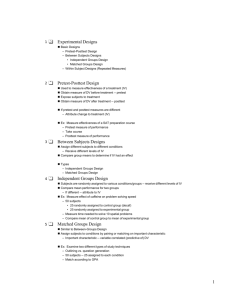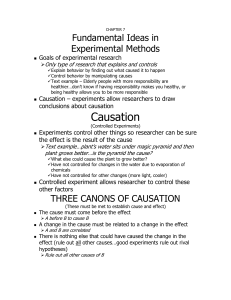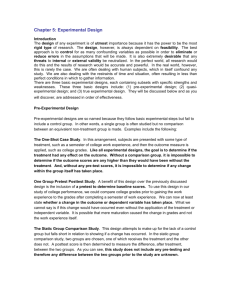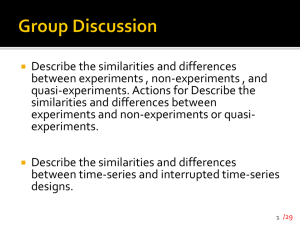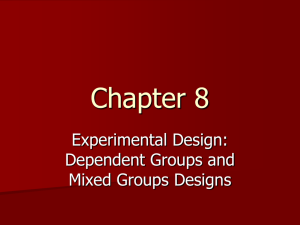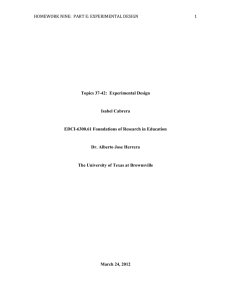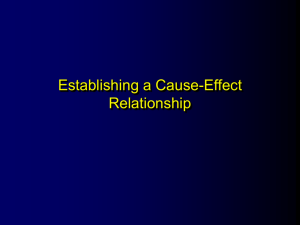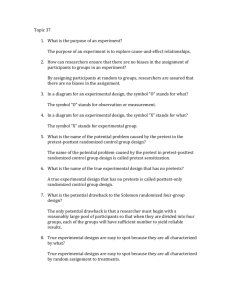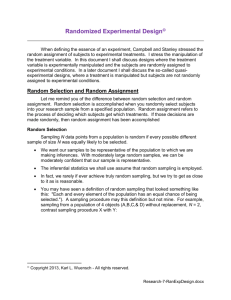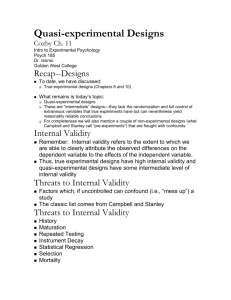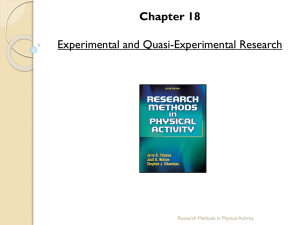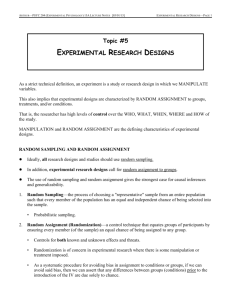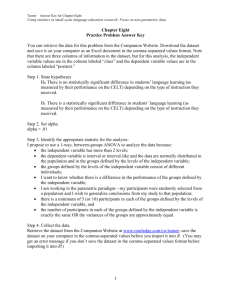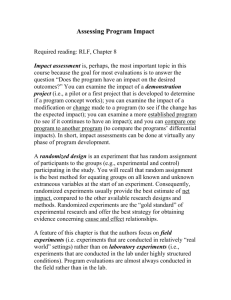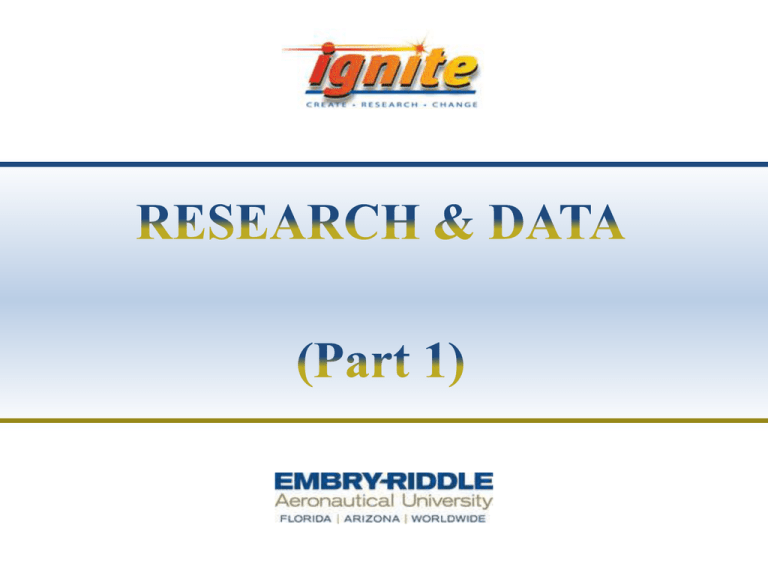
Purpose of this Section of the Research Support Lab
Purpose of This RSL Part:
• Make statistics fun!
• Make you into a statistician!
• Introduce you to basic concepts and procedures in descriptive and inferential
statistics
• Prepare you for subsequent statistical courses
Overview of These RSL Parts:
• Begins with methods for describing and summarizing single-variable
(frequency) distributions followed by methods for describing relationships
between two (or more) variables.
• Then introduce probability theory as background for understanding
inferential statistics.
• Methods are then presented for drawing inferences from research samples to
populations from which the samples were drawn.
• Statistical tests covered include z-tests, t-tests, analysis of variance
(F-tests), and nonparametric tests
2
Textbook Credits
• Textbook
Shavelson, R.J. (1996). Statistical reasoning for the behavioral
sciences (3rd Ed.). Boston: Allyn & Bacon.
• Supplemental Material
Ruiz-Primo, M.A., Mitchell, M., & Shavelson, R.J. (1996).
Student guide for Shavelson statistical reasoning for the
behavioral sciences (3rd Ed.). Boston: Allyn & Bacon.
3
Statistical Software
•
•
•
•
•
•
•
Excel
MegaStat
Minitab
SPSS
JMP
POM/QM
StatCrunch
4
Research Defined
• Research is doing one’s damnedest to answer perplexing
questions…
• Or research is a systematic approach to finding answers to
questions
• Scientific research, our focus, seeks answers to questions
empirically and by inference, ruling out counter-interpretations
to the one justified by the data
• With the scientific method, problems are formulated,
hypotheses are identified, data are collected, inferences are
drawn about which hypothesis is more credible
• The purpose of empirical research, therefore, is to provide
answers to questions about behavior using the scientific method
5
Statistics Defined
• Statistics is the science of conducting studies to collect, organize,
summarize, analyze, and draw conclusions from data.
• Descriptive statistics consists of:
–
–
–
–
the collection
Organization
Summarization
presentation of data
• Inferential statistics consists of:
–
–
–
–
–
generalizing from samples to populations
performing estimations
hypothesis testing
determining relationships among variables
making predictions
6
Research Questions/Steps in Conducting Research
Research Questions
• What is happening?
• Is there a systematic (causal) effect?
• Why or how is it happening (“mechanism”)?
Steps in Conducting Research
1.
2.
3.
4.
5.
6.
Identify and define a research problem
Formulate hypothesis based on theory, research, or both
Design the research
Conduct the research
Analyze the data
Interpret the data as they bear on the research question
7
Data Collection and Sampling Techniques
• Surveys are the most common method of collecting data. Three
methods of surveying are:
– Telephone surveys
– Mailed questionnaire surveys
– Personal interviews
• Other methods include historical data gathering (empirical data)
8
Some Terminology
Variable: is a characteristic or attribute that can assume different values(height,
ability)
Data are the values that variables can assume.
Random variables have values that are determined by chance.
A population consists of all subjects that are being studied.
A sample is a group of subjects selected from a population.
Random samples are selected using chance methods or random methods.
Independent Variable(Factor/Treatment): A variable that is measured , manipulated
(type of instruction), or selected (e.g., sex) to determine its relationship to some other
observed variable.
Control Variable: A variable which is held constant (or is “controlled”) to neutralize its
effect on the dependent variable because it is not the focus of the study (e.g., control
on sex in a reading study)
Intervening Variable: A conceptual or theoretical variable that accounts for the
relation between independent and dependent variable; an explanation for the
relation or a hypothesized mechanism that accounts for the relation.
Dependent Variable(Response): A variable that is observed and measured to
determine its response to the independent variable (i.e., dependent on the
independent variable)
9
Measurement Scales
• Nominal—classifies data into mutually exclusive (nonoverlapping), exhausting categories in which no order or ranking
can be imposed on the data.
• Ordinal—classifies data into categories that can be ranked;
however, precise differences between the ranks do not exist.
• Interval—ranks data, and precise differences between units of
measure do exist; however, there is no meaningful zero.
• Ratio—possesses all the characteristics of interval measurement,
and there exists a true zero.
10
Measurement Scales: Classification of Data
Nominal
level data
Ordinal
level data
Interval
level data
Ratio
Level data
Zip code
Grade
SAT score
Height
Gender
Rating
IQ
Weight
Eye color
Ranking
Temperature
Time
11
Some Terminology: Summation Notation
Summation notation is mathematical notation commonly
used in statistics
It’s really simple if you pause, take a deep breath, relax and
enjoy it… a little patience goes a long ways
N
Mean X X p / N ( X 1 X 2 ... X p ... X N ) / N
p 1
12
Research Designs
• Pre-experimental Designs
– One-shot Case Study (Treatment group only)
– One Group Pretest to Posttest Design—measures of change
– Intact Group Comparison at posttest
• Experimental Designs
Random assignment to “treatment” & control group
– Posttest Only Control Group
– Pretest-Posttest Control Group
– Factorial
• Quasi-experimental Designs
Non-random assignment to “treatment” & control group observed
– Nonequivalent-Control Group Design
– Time-Series Design
• Ex-Post Facto Designs
Statistical controls for comparing alternative “treatments”
– Correlational Design
– Criterion-Group Design
14
Pre-experimental Designs
• One-shot Case Study (Treatment group only)
X
O
Example:
“X” is a new personnel policy, a job satisfaction measurement is taken, and then a response is observed
• One Group Pretest to Posttest Design—measures change
O1
X
O2
Example:
A job satisfaction measurement is taken before and after treatment “X” is applied
• Intact Group Comparison at posttest
G1
X
O
G2
Control
O
Example:
G1 receives the treatment, G2 does not; then a job satisfaction measurement is taken and observed
(in this case G1 and G2 may represent two different business units)
15
Experimental Designs
Random assignment to “treatment” & control group
• Posttest Only Control Group
• Pretest-Posttest Control Group
X
O
O1
Control
O
O1 Control
• Factorial
X
O2
O2
X2
X1
O
X2
Control
O
Example:
A job satisfaction measurement is taken after treatment “X1” is applied or not and graveyard shift
“X2” is implemented
16
Quasi-experimental Designs
Non-random assignment to “treatment” & control group observed.
Include one or more control groups.
• Nonequivalent-Control Group Design
G1
O1
X
O2
G2
O1 Control
O2
Subjects receive a pretest (O1) treatment or non-treatment and then receive a posttest (O2)
• Time-Series Design
…
X
O1
…
O2
Multiple observations are taken before and after a treatment is administered. Pretreatment
observations establish a control group baseline. Post-treatment observations establish a consistent
change in response.
17
Ex-Post Facto Designs
Statistical controls for comparing “treatment” and “control”
(relationships between two variables). Called ex-facto because the
researcher arrives after the treatment has been administered.
•Correlational Design
O1
O2
SAT scores (O1) and GPA (O2) are collected.
•Criterion-Group Design
G1
O
G2
O
Group 2 is compared to Group 1
18
Threats to Internal Validity
• History:
- something co-occurring with the treatment caused the outcome
• Maturation
- maturation, not the treatment, caused the outcome
• “Mortality”
- loss of poorly performing subjects from a group caused the outcome
• Statistical Regression
- extreme groups are likely to improve on retesting
• Selection bias
- the differences in outcomes existed before the treatments were given
• Instrumentation
- outcome measure not reliable, valid, or both
• Testing
- pretest cued subjects to outcome measure
• Stability
- Type I Error
19
History Threat
Occurrence of events other
than the independent variable.
Treatment (X)
Control
20
Maturity Threat
There may be developmental
(physical or mental) changes
occurring to the subjects during the
time of the experiment
Treatment (X)
21
Mortality Threat
Treatment (X)
Some subjects drop out
the study and they have
something in common,
say, low achievement.
22
Regression Threat
Treatment (X)
The groups were selected on the basis
of extreme score. (Regression effect:
low-extreme tends to increase, highextreme tends to drop)
23
Selection Threat
Treatment (X)
Initial difference
exist in groups
Control
24
Instrumentation Threat
?
Treatment (X)
?
The measuring instruments is not reliable
or not valid, therefore, the score obtained
by subjects could not be accurate.
25
Testing Threat
Pretest
Treatment (X)
The subject learns from the pretest,
therefore, scores better on the
posttest
26
Testing Threat
H0 True
Reject
H0
Do not reject
H0
H0 False
Type I
Error
producers risk
(a)
Correct
Decision
Correct
Decision
Type II
Error
consumers
risk
(b)
A type I error occurs if one rejects the null hypothesis when it is true.
A type II error occurs if one does not reject the null hypothesis when it is false.
27
Ideal Model
Experimental Design
(Control Group + Random Assignment)
Treatment (X)
Randomly
Assigned
Control
28
Practice Exercises
1.
Select two out of the four major Research Designs.
2.
Support your two selected research designs with original
hypothetical examples as outlined in this presentation.
3.
Compare and contrast them with one another.
4.
Indicate all threads to validity that you can document.
29


